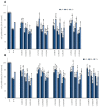Chickpea Sprouts as a Potential Dietary Support in Different Prostate Disorders-A Preliminary In Vitro Study
- PMID: 38474555
- PMCID: PMC10934777
- DOI: 10.3390/molecules29051044
Chickpea Sprouts as a Potential Dietary Support in Different Prostate Disorders-A Preliminary In Vitro Study
Abstract
Background: Prostate cancer (PC) and benign prostatic hyperplasia (BPH) are common health problems in the aging male population. Due to the unexplored and unconfirmed impact of food containing isoflavones, like sprouts, on the development of the management of BPH and prostate cancer, we decided to extend the knowledge in this area.
Results: We have demonstrated for the first time that chickpea sprouts may play an important role in the chemoprevention of prostate disorders. However, attention should be paid to the isoflavone content in the sprouts, as in our study, chickpea sprouts with a moderate concentration of the compounds, harvested in natural light conditions (CA10L) and blue LED light (CA7B), showed the best scores in terms of their potential towards prostate disorders.
Methods: Chickpea seeds were grown in LED chambers. The methanol extracts from sprouts were quantitatively defined using the HPLC system. Experiments such as the determination of PSA, 5-α-reductase, and dihydrotestosterone were performed on PNT2 and LNCaP cells. For anti-inflammatory assays (determination of NO, IL-6, and TNF-alpha release), murine RAW264.7 macrophages were used.
Conclusions: The role of legume products as a diet element should be deeply evaluated for the development of future dietary recommendations for prostate cancer and BPH prevention.
Keywords: benign prostatic hyperplasia; chickpea sprouts; prostate cancer; prostate disorders.
Conflict of interest statement
The authors declare no conflicts of interest.
Figures





Similar articles
-
Isoflavone content and composition in chickpea (Cicer arietinum L.) sprouts germinated under different conditions.J Agric Food Chem. 2015 Mar 18;63(10):2701-7. doi: 10.1021/jf5057524. Epub 2015 Mar 5. J Agric Food Chem. 2015. PMID: 25630489
-
Chickpea and Lupin Sprouts, Stimulated by Different LED Lights, As Novel Examples of Isoflavones-Rich Functional Food, and Their Impact on Breast and Prostate Cells.Molecules. 2022 Dec 18;27(24):9030. doi: 10.3390/molecules27249030. Molecules. 2022. PMID: 36558162 Free PMC article.
-
The estrogenic activity of isoflavones extracted from chickpea Cicer arietinum L sprouts in vitro.Phytother Res. 2013 Aug;27(8):1237-42. doi: 10.1002/ptr.4858. Epub 2012 Oct 15. Phytother Res. 2013. PMID: 23065723
-
Nutraceutical treatment and prevention of benign prostatic hyperplasia and prostate cancer.Arch Ital Urol Androl. 2019 Oct 2;91(3). doi: 10.4081/aiua.2019.3.139. Arch Ital Urol Androl. 2019. PMID: 31577095 Review.
-
The controversial relationship between benign prostatic hyperplasia and prostate cancer: the role of inflammation.Eur Urol. 2011 Jul;60(1):106-17. doi: 10.1016/j.eururo.2011.03.055. Epub 2011 Apr 9. Eur Urol. 2011. PMID: 21497433 Review.
Cited by
-
Can Simulated Microgravity and Darkness Conditions Influence the Phytochemical Content and Bioactivity of the Sprouts?-A Preliminary Study on Selected Fabaceae Species.Plants (Basel). 2024 May 30;13(11):1515. doi: 10.3390/plants13111515. Plants (Basel). 2024. PMID: 38891323 Free PMC article.
References
MeSH terms
Substances
Grants and funding
- No. 06/IDUB/2019/94/The qLIFE Priority Research Area under the program "Excellence Initiative-Research University" at Jagiellonian University.
- 1.012.996.2020/POB qLIFE, grant titled "Search for new can-didates for phytoestrogen-rich functional foods, based on a cellular model of hormone-dependent cancers and chemometric analysis of safety and efficacy"
LinkOut - more resources
Full Text Sources
Medical
Research Materials
Miscellaneous

